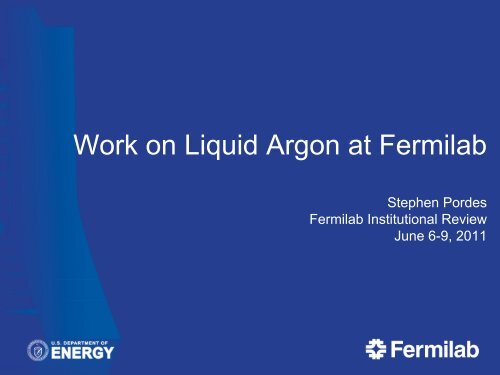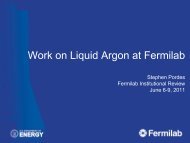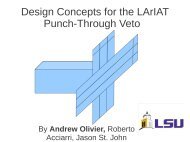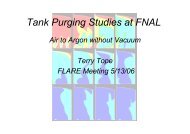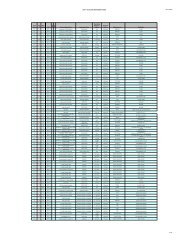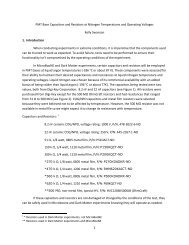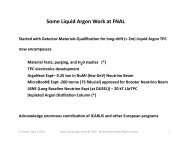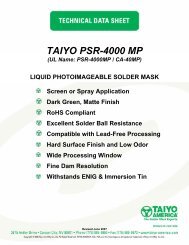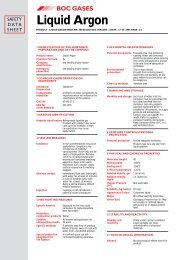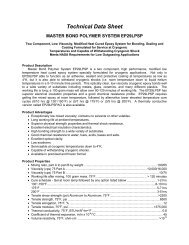DM - LArTPC DocDB - Fermilab
DM - LArTPC DocDB - Fermilab
DM - LArTPC DocDB - Fermilab
You also want an ePaper? Increase the reach of your titles
YUMPU automatically turns print PDFs into web optimized ePapers that Google loves.
Work on Liquid Argon at <strong>Fermilab</strong><br />
Stephen Pordes<br />
<strong>Fermilab</strong> Institutional Review<br />
June 6-9, 2011
Outline<br />
• Introduction<br />
• Many individual topics<br />
• Conclusion<br />
2<br />
<strong>Fermilab</strong> Institutional Review, June 6-9, 2011
Introduction Liquid Argon – Why<br />
Liquid Argon is a powerful Scintillator (40,000 photons/MeV)<br />
and allows free electrons to drift meters under practical<br />
strength electric fields.<br />
It presents an attractive Target Medium for:<br />
Neutrino interactions where liquid Argon TPCs can produce<br />
bubble-chamber quality event images;<br />
Dark Matter searches which exploit features of light and free<br />
charge produced in Argon by the recoiling nucleus to achieve<br />
excellent background rejection.<br />
3<br />
<strong>Fermilab</strong> Institutional Review, June 6-9, 2011
Introduction - Some Context (1)<br />
Technique pioneered by ICARUS collaboration over 30 years under<br />
C. Rubbia.<br />
Work at <strong>Fermilab</strong> started by A. Para in ~ 2004<br />
Evolved into significant program at <strong>Fermilab</strong>, including<br />
• R & D facilities at PAB and the Liquid Argon Purity Demonstration<br />
• ArgoNeuT exposure to NuMI beam<br />
• MicroBooNE experiment (E-974) about to undergo CD-2 review,<br />
• Liquid Argon proposal in the LBNE (Long Baseline Neutrino Expt)<br />
• DarkSide 50 Dark Matter Search<br />
• LArSoft General Software Project for <strong>LArTPC</strong> detectors<br />
4<br />
<strong>Fermilab</strong> Institutional Review, June 6-9, 2011
Introduction - Some Context (2)<br />
Institutions collaborating in hardware R & D:<br />
• Yale - Syracuse (ArgoNeuT construction and exposure)<br />
• Michigan State University (TPC electronics)<br />
• M.I.T and Indiana University (Light readout)<br />
• BNL (TPC electronics and TPC design)<br />
• Princeton (depleted Argon recovery and special cryogenics)<br />
• UCLA (development of infrastructure for QUPID)<br />
5<br />
<strong>Fermilab</strong> Institutional Review, June 6-9, 2011
Introduction Neutrino & Dark Matter Synergies<br />
Technical Issues for Multi-ton Argon Neutrino detector:<br />
• Chemical purity to allow electron drift (10’s ppt O2 equivalent),<br />
• Chemical purity to allow light production and propagation<br />
• Cryostat and Cryogenics and associated safety issues<br />
• TPC design<br />
• TPC readout electronics<br />
• HV feedthroughs (>100 kV) and distribution<br />
• Light Detection<br />
• Data Acquisition<br />
• Detector Materials Qualification<br />
6<br />
<strong>Fermilab</strong> Institutional Review, June 6-9, 2011
Introduction Neutrino & Dark Matter Synergies<br />
Technical Issues for Neutrino or <strong>DM</strong> Argon detector:<br />
• Chemical purity to allow electron drift (10’s ppt O2), (ν and <strong>DM</strong>)<br />
• Chemical purity to allow light production and propagation (ν and <strong>DM</strong>)<br />
• Cryostat and Cryogenics and associated safety issues (ν and <strong>DM</strong>)<br />
• TPC design (ν and <strong>DM</strong>)<br />
• TPC readout electronics (ν)<br />
• HV feedthroughs (>100 kV) and distribution (ν and <strong>DM</strong>)<br />
• Light Detection (ν and <strong>DM</strong>)<br />
• Data Acquisition (ν and <strong>DM</strong>)<br />
• Detector Materials Qualification (ν and <strong>DM</strong>)<br />
• Shielding from environment radiation (<strong>DM</strong>)<br />
• Radio-purity of detector materials (<strong>DM</strong>)<br />
• Radio purity of Argon (<strong>DM</strong>)<br />
7<br />
<strong>Fermilab</strong> Institutional Review, June 6-9, 2011
Facilities – Liquid Argon Setup at the PAB<br />
8<br />
<strong>Fermilab</strong> Institutional Review, June 6-9, 2011
Facilities – Schematic of Materials Test Stand<br />
9<br />
<strong>Fermilab</strong> Institutional Review, June 6-9, 2011
Liquid Argon Materials Test System Features<br />
Opera&on Features of Materials Test System <br />
• External Filters regenerated in place <br />
• Can insert materials into known clean argon <br />
• Can insert materials a6er purging only or a6er pumping on them <br />
• Can posi:on materials into liquid and into ullage giving range of temperatures <br />
• Can insert known amounts of contaminant gases <br />
• Nitrogen-‐based condenser can maintain liquid for long (weeks) studies <br />
• Internal filter-‐pump can remove contamina:on introduced by materials – 2hr cycle <br />
• Argon sample points at source, a6er single-‐pass filters, and in cryostat gas and <br />
liquid <br />
10<br />
<strong>Fermilab</strong> Institutional Review, June 6-9, 2011
Measurement Features of Materials Test System <br />
• Measure electron dri6 life:me (0.3 milliseconds to 10 milliseconds) <br />
• Measure Oxygen (0.5 ppb sensi:vity) with oxygen meter (Delta-‐F & Tiger Op:cs) <br />
• Measure H20 in gas (0.5 ppb sensi:vity) with water meter (Tiger Op:cs) <br />
• Cryogenic data, Life:me Data, analy:c instrumenta:on data in single data-‐base <br />
• Runs 24/7 unaYended -‐ except for filter regenera:on and argon refills <br />
Lifetime Monitor Signals<br />
Anode<br />
Lifetime<br />
Monitor<br />
Analysis<br />
Cathode<br />
Lifetime<br />
Monitor a la<br />
ICARUS<br />
11<br />
<strong>Fermilab</strong> Institutional Review, June 6-9, 2011
Materials Test Stand Automation<br />
Cryogenics Control Panel<br />
12<br />
<strong>Fermilab</strong> Institutional Review, June 6-9, 2011
Materials Test Stand<br />
Typical data<br />
Some data samples<br />
Material Date test started Preparation Tests Water [ppb] Lifetime [ms] LogBook #<br />
! Cleaning Solution 6/29/09 evac. 24 h vapor/liquid 4 5 946<br />
" Vespel 7/9/09 evac. overnite liquid/vapor 5-7 2-5, 4-6 960<br />
# MasterBond glue 7/16/09 purged 18 h vapor/liquid 1.6 1.3- 2.9 974<br />
$ Bostik didn't pass submerging in the liquid argon 992<br />
% LEDs 7/31/09 purged 38 h vapor 3.5 5 993<br />
& Carbon filter material 8/12/09 evac. 24 h liquid/vapor 2 4-9 1000<br />
' 962 FeedTru Board V2 10/12/09 evac. 24 h vapor/warm 85 1-5 1062<br />
( Teflon cable 1/9/10 purged 28 h warm/liquid/vapor 8-20 2-5 1175<br />
!) 3M "Hans" connectors 1/29/10 purged 46 h warm/liquid/vapor 5-12 3 1198<br />
!! 962 capacitors 3/2/10 evac. 24 h warm/liquid/vapor 6-14 3-6 1228<br />
!" 962 polyolefin cable 4/12/10 evac. 16 days warm 25-60 2 1237<br />
!# Rigaku feedthrough 4/20/10 purged 7.5 h warm 15 3 1250<br />
!$ Rogers board (Teppei) 4/23/10 purged 26 h warm/liquid/vapor 40 2, 6-10 1254<br />
!% Arlon Board (Teppei) 5/14/10 evac. 0.5 h, pur.2 days warm/vapor 300, 80 1.3, 3.5 1263<br />
!& Polyethylene tubing 5/24/10 evac. 6 h, pur. 66 h warm 300-500 1 1278<br />
!' Teflon tubing 5/27/10 evac. 1 h, pur.17 h warm 9-13 4-5 1283<br />
!* Jonghee board 5/28/10 evac. 6 h, pur. 1.5 h warm/vapor 100,28 1.2, 5-8 1285<br />
!( Jonghee connectors 6/4/10 evac. 3.5 h, pur. 16 h warm/vapor 50 2-3 1290<br />
") PVC cable 6/14/10 evac. 29 h, pur.1 h warm 120 1-2 1296<br />
"! Teppei TPB samples 8/3/10 purged 26 h warm 600-1600 0.7 1342<br />
13<br />
<strong>Fermilab</strong> Institutional Review, June 6-9, 2011
Materials Test Stand Summary<br />
Filter Materials:<br />
Industrial filter materials are capable of removing all electronegative materials (water,<br />
oxygen)and producing liquid with >10 milliseconds lifetime.<br />
Data on filter capacity at our requirements are sparse;<br />
Filters can be regenerated many times; we know how - using non-flammable Ar-H mix<br />
Materials:<br />
Materials immersed in the liquid have no effect on lifetime;<br />
Materials immersed in warm gas volume above the argon have:<br />
no effect on lifetime if the argon is venting at a certain rate;<br />
significant effect if the warm gas mixes with the liquid argon directly;<br />
metal surfaces outgas water vapor at significant rate and ... see above<br />
Contaminants:<br />
Absent leaks, water is the main concern; it comes from detector materials and the<br />
cryostat walls in the warm gas.<br />
`A system to test the effects of materials on the electron drift lifetime in liquid argon and observations on the<br />
effect of water’ R. Andrews et al., Nucl.Instrum.Meth.A608:251-258,2009.<br />
14<br />
<strong>Fermilab</strong> Institutional Review, June 6-9, 2011
LAr TPC Electronics Test Stand<br />
MSU<br />
Electronics<br />
& DAQ<br />
1 st LAr TPC with U.S.<br />
electronics readout<br />
50 cm vertical drift TPC<br />
HV 20 - 30 kV<br />
3 planes of wires at 120 0<br />
FNAL TPC<br />
HV Feedthrough<br />
Argon<br />
15<br />
<strong>Fermilab</strong> Institutional Review, June 6-9, 2011
wire<br />
few channels<br />
show a hit<br />
LAr TPC Raw Signals<br />
wire<br />
Drift time<br />
all channels<br />
show a hit<br />
Served as the test bed for<br />
development of ArgoNeuT<br />
electronics, and motivated the<br />
development of software hit<br />
reconstruction techniques based<br />
on FFT.<br />
Drift time<br />
wire<br />
all channels<br />
show a hit<br />
Drift time<br />
16<br />
<strong>Fermilab</strong> Institutional Review, June 6-9, 2011
Example of use of TPC data – for electronics development<br />
Raw Data<br />
Collection plane<br />
filter B<br />
`Hits’ found<br />
15 cm<br />
filter A<br />
drift time -><br />
30 cm<br />
wire # -> (1-32)<br />
wire # -> (1-32)<br />
Induction plane<br />
filter C<br />
wire # -> (1-32)<br />
filter D<br />
drift time -><br />
wire # -> (1-32)<br />
J. Spitz (Yale)<br />
Ionization signals are small (~15,000 e) and slow – important to restrict<br />
bandwidth of system. Note the signal region is broader with filters B & D<br />
which have acceptance at lower frequency. These sort of data were used to<br />
optimize front-end filter bandwidth for resolution and two-track separation.<br />
17<br />
<strong>Fermilab</strong> Institutional Review, June 6-9, 2011
Electronics Test System: in-liquid electronics<br />
For enormous (multi-kiloton) LAr TPCs, there are significant advantages in<br />
being able to put the electronics in the liquid argon and to multiplex the signals<br />
before transmitting them out of the cryostat.<br />
Advantages:<br />
• Lower capacitance seen by the first amplifier close to the wire leads to<br />
better signal to noise<br />
• Ability to put amplifiers anywhere required avoids either having to bring all<br />
signals to top of detector, or to have feed-throughs in liquid.<br />
• Multiplexing signals reduces number of feed-throughs and thus reduces cost<br />
and chance of leaks.<br />
• Multiplexing signals reduces cable plant inside detector and thus reduces<br />
sources of contamination and out-gassing.<br />
18<br />
<strong>Fermilab</strong> Institutional Review, June 6-9, 2011
1 st in-liquid CMOS electronics on a <strong>LArTPC</strong><br />
Built at Michigan State University<br />
CMOS based design.<br />
Available technology.<br />
Operates well at 90K.<br />
Can be converted into<br />
ASIC.<br />
Capacitors and Inductors<br />
require careful selection.<br />
Connectors and cabling<br />
need careful testing.<br />
Ground connections need<br />
robust mechanics.<br />
19<br />
<strong>Fermilab</strong> Institutional Review, June 6-9, 2011
In-liquid electronics Raw Data<br />
All 144 channels work<br />
S/N looks promising<br />
Analysis in progress<br />
PPD EE dept. looking at<br />
long term issues to do<br />
with operation at low T<br />
wire<br />
20<br />
time<br />
<strong>Fermilab</strong> Institutional Review, June 6-9, 2011
ArgoNeuT-T962: <strong>LArTPC</strong> exposed to NuMI Beam<br />
FNAL, Italy, MSU, Syracuse,<br />
Yale<br />
1m x 50 cm x 50 cm<br />
2 views +/- 30 0 to vertical<br />
480 channels total<br />
Ran in NuMI beam<br />
neutrino (1 month)<br />
anti-neutrino (4 months)<br />
21<br />
<strong>Fermilab</strong> Institutional Review, June 6-9, 2011
ArgoNeuT event with 4 photon conversions<br />
400<br />
360<br />
time (µs)<br />
Collection Plane<br />
320<br />
280<br />
240<br />
200<br />
160<br />
4<br />
1<br />
2<br />
3<br />
65 cm<br />
120<br />
80<br />
40<br />
100 cm<br />
400<br />
360<br />
time (µs)<br />
Induction Plane<br />
320<br />
280<br />
240<br />
200<br />
160<br />
1<br />
4<br />
2<br />
3<br />
65 cm<br />
120<br />
80<br />
40<br />
Channel No.<br />
Invaluable data set on ν interactions in Argon<br />
Analysis in progress – results in Summer<br />
22<br />
<strong>Fermilab</strong> Institutional Review, June 6-9, 2011
Achieving good lifetime in an unevacuated vessel<br />
Liquid Argon Purity Demonstration<br />
Demonstrate good life-time in an<br />
industrial vessel without evacuation.<br />
All previous detectors have been<br />
evacuated before filling<br />
Atmosphere will be removed by<br />
`argon’ piston, then argon gas will be<br />
circulated through filters to achieve<br />
~ 1 ppm Oxygen.<br />
Heaters in the insulation can warm the<br />
walls to 60 C.<br />
Filtration system sized for 30 tons of<br />
Argon at 1 ppm Oxygen. Pump will<br />
circulate entire volume in
Electron Drift-Lifetime Measurement and …<br />
Measure evolution of gas-purge using exhaust tubes at different heights (sniffer);<br />
Measure liquid temperatures throughout tank and compare with models to understand<br />
convective flow<br />
24<br />
<strong>Fermilab</strong> Institutional Review, June 6-9, 2011
Some steps on the path to the LBNE 25 ktonne cryostat<br />
based on Membrane panel construction as used in LNG carriers<br />
Well-suited to construction in a cavern.<br />
LAr 35t LAr1 LAr20<br />
Demonstration of<br />
the membrane<br />
cryostat technology<br />
Prototype of the<br />
LAr20 detector<br />
validating TPC<br />
design and the<br />
assembly<br />
procedures.<br />
One module of the<br />
LBNE detector<br />
25<br />
<strong>Fermilab</strong> Institutional Review, June 6-9, 2011
LNG tanker membrane cryostat<br />
Roof nozzle penetration<br />
26<br />
<strong>Fermilab</strong> Institutional Review, June 6-9, 2011
First steps with the Membrane Technology<br />
Need some R & D to develop alternative leak-checking procedures to avoid use of<br />
contaminating chemicals<br />
27<br />
<strong>Fermilab</strong> Institutional Review, June 6-9, 2011
Plans for siting LAr35t and LAr1<br />
Showing the LAr35t cryostat using<br />
the same cryogenics and purification<br />
system as developed for the Liquid<br />
Argon Purity Demonstration<br />
The LAr1 (ktonne) is intended to<br />
be built in the DZero pit where<br />
there is already significant liquid<br />
argon infrastructure.<br />
28<br />
<strong>Fermilab</strong> Institutional Review, June 6-9, 2011
Light Readout R & D (M.I.T & Indiana)<br />
Light signal might be a useful trigger. Argon light is 128 nm and wave-lengthshifters<br />
(WLS) are used to convert the 128 nm to visible.<br />
Typical arrangement is for PMTs with WLS around the periphery.<br />
This is both costly (paying for PMT area) and inefficient for large volume<br />
detectors. Can one wave-length shift and collect light throughout volume and<br />
route it to photodetectors?<br />
A concept: clear polystyrene light guide clad with thin layer of WLS in a<br />
polystyrene matrix. Issue is attenuation length along the light-guide because of<br />
the cladding layer.<br />
A sample of polystyrene bar co-extruded<br />
(by the NICADD extruder) with an outside<br />
layer of polystyrene containing 1.5% bis-<br />
MSB. Note the blue is only evident at the<br />
surface, not throughout the volume.<br />
29<br />
<strong>Fermilab</strong> Institutional Review, June 6-9, 2011
LAr for Dark Matter: Depleted Argon Distillation Column<br />
Atmospheric Argon contains 1 part in 10 15 of 39 Ar, half-life ~270 yrs, end-point 565 keV.<br />
This gives a background rate of 1 Bq/kg which limits the size of LAr Dark Matter 2-phase<br />
TPCs to ~ 1 ton because of dead-time.<br />
The 39 Ar comes from interactions of cosmic rays on 40 Ar in the atmosphere. Underground<br />
Argon is not subject to these interactions.<br />
Commercial CO 2 wells have been found * which contains 400 ppm Argon with
Distillation Column Design and Realization<br />
Designed to produce 99.999% pure Ar<br />
Looking up the column<br />
5.5 cm<br />
66 stages<br />
Column packing material<br />
31<br />
<strong>Fermilab</strong> Institutional Review, June 6-9, 2011
First Distillation – Batch Mode works<br />
Can distill efficiently but only in batch mode<br />
Upgrades planned to improve cooling at input to achieve continuous distillation<br />
Cryo-Booster (to put Argon into high pressure cylinders) is to be brought online<br />
32<br />
<strong>Fermilab</strong> Institutional Review, June 6-9, 2011
One Slide on Software<br />
It is recognized that detector simulation and event reconstruction are important<br />
for the success of the Lar technology, and present a significant challenge given<br />
the wealth of data the detector provides.<br />
LArSoft is a framework for Detector Simulation and Reconstruction in Liquid<br />
Argon TPCs.<br />
It is supported by the <strong>Fermilab</strong> Computing Division in its ART framework.<br />
It provides many types of event (Cosmic Ray, Neutrino Interaction, Single<br />
Particle) and propagates the resultant charge (and light) through the Argon.<br />
The user defines the detector geometry and signal processing.<br />
LARSoft has contributors from:<br />
Bern (CH), Columbia University, <strong>Fermilab</strong>, LNGS (It), Kansas State University,<br />
M.I.T., Michigan State University, Syracuse and Yale.<br />
33<br />
<strong>Fermilab</strong> Institutional Review, June 6-9, 2011
LArSoft Simulation of a π 0 in ArgoNeut - cf slide 22<br />
400<br />
360<br />
320<br />
280<br />
240<br />
200<br />
160<br />
120<br />
80<br />
40<br />
400<br />
360<br />
320<br />
280<br />
240<br />
200<br />
160<br />
120<br />
80<br />
40<br />
time (µs)<br />
time (µs)<br />
100 cm<br />
Channel No<br />
65 cm<br />
65 cm<br />
34<br />
<strong>Fermilab</strong> Institutional Review, June 6-9, 2011
Conclusions<br />
Vigorous and broad range of activities in Liquid Argon<br />
Stimulating technical challenges and a collaborative environment<br />
Comprehensive program of tests and prototypes towards LBNE<br />
and/or other deployment of multi-kiloton detectors<br />
Synergies with Dark Matter searches recognized and exploited<br />
Recognition of the importance of simulation and reconstruction<br />
software and a serious commitment to their development.<br />
35<br />
<strong>Fermilab</strong> Institutional Review, June 6-9, 2011
Backups<br />
36<br />
<strong>Fermilab</strong> Institutional Review, June 6-9, 2011
Introduction Neutrino & Dark Matter Synergies<br />
Technical Issues for Neutrino or <strong>DM</strong> Argon detector:<br />
• Chemical purity to allow electron drift (10’s ppt O2), (ν and <strong>DM</strong>)<br />
• Chemical purity to allow light production and propagation (ν and <strong>DM</strong>)<br />
• Cryostat and Cryogenics and associated safety issues (ν and <strong>DM</strong>)<br />
• TPC design (ν and <strong>DM</strong>)<br />
• TPC readout electronics (ν)<br />
Issues being addressed<br />
• HV feedthroughs (>100 kV) and distribution (ν and <strong>DM</strong>)<br />
• Light Detection (ν and <strong>DM</strong>)<br />
• Data Acquisition (ν and <strong>DM</strong>)<br />
• Detector Materials Qualification (ν and <strong>DM</strong>)<br />
• Shielding from environment radiation (<strong>DM</strong>)<br />
• Radio-purity of detector materials (<strong>DM</strong>)<br />
• Radio purity of Argon (<strong>DM</strong>)<br />
37<br />
<strong>Fermilab</strong> Institutional Review, June 6-9, 2011
38<br />
<strong>Fermilab</strong> Institutional Review, June 6-9, 2011


